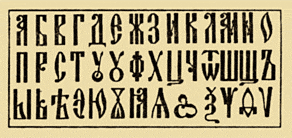The paper examines the role of the Slavonic script in formulations of identity and authenticity in post-Soviet Russia. Without doubt the “semiotic landscape” (Kress and van Leeuwen 2006) of Russia has witnessed extraordinary changes in the post-communist period, including the elimination of Soviet emblems and statuary, the propagation of religious symbolism, and the massive influx of Western loanwords (often in the Roman alphabet). To some the landscape—and hence the nation itself—has appeared under siege. As one critic declaimed, “Do our cities not resemble cities subjugated by alien countries, their streets made gaudy by foreign language advertisements and signs, not infrequently, appearing in Latin letters?” (quoted in Gorham, "Natsiia ili snikerizatsiia? Identity and Perversion in the Language Debates of Late-and Post-Soviet Russia", 2000). For such critics the Slavonic script represents a potent symbol of Russia against the encroaching Other.
Ever since Peter the Great created the more Latinate “civil script” in 1708—what is now typically called Cyrillic or Russian—the older Slavonic script (see Figure below) has been associated with the “authentic” historical and religious roots of Russia. With the collapse of the USSR, the ornate and obsolete letterforms of Slavonic have assumed a heightened visibility in the semiotic landscape. The script is central to the Russian Orthodox Church, which still uses the Church Slavonic language in its publications and liturgies. But it also functions as a kind of shibboleth for various ‘Red-Brown’ groups.
Dozens of monarchist, ultra-nationalist, white supremacist, and neo-fascist periodicals have been published in Russia since the early 1990s. Examples include Russkii Stiag, Russkoe Voskrecenie, Parvoslavnyi Partisan, Veche, Pamiat’, Kolokol’, Rus’ Pravoslavnyi and Pravoslavie ili Smert’. The use of the archaic Slavonic script is a consistent and constitutive element of these publications, most prominently in the masthead. The script is often combined with tsarist symbols such as the double-headed eagle, communist symbols such as the hammer and sickle, religious symbols such as the cross, and fascist symbols such the swastika—or some combination thereof, depending on the group’s ideology. Harsh political cartoons denigrating Jews are another staple of the genre. In such media one sometimes finds Slavonic fonts set in opposition to Latin or (faux) Hebrew—a kind of “clash of civilizations” expressed in typographic form.
In sum, this extremist literature from post-Soviet Russia demonstrates how script and symbol are matters of identity and authenticity in the globalizing city.
Figure:

Source: A. Zinov’ev, Tainopis’ kirillitsy (Vladimir 1998)